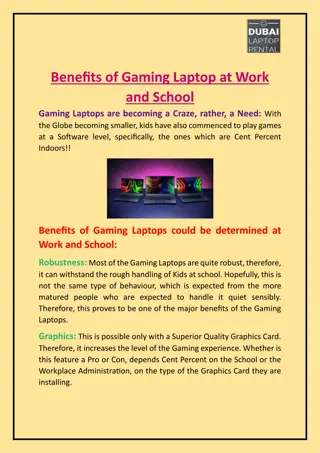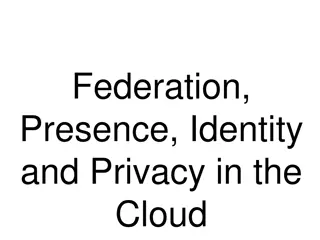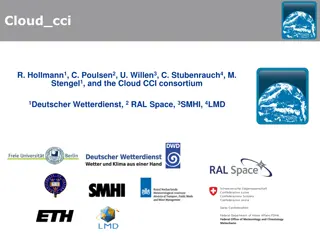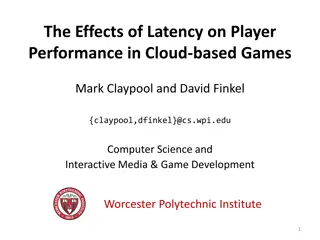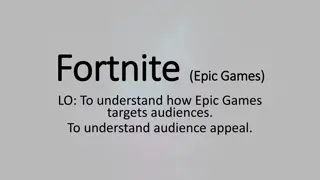Cloud Gaming: Architecture, Performance, and Challenges
Explore the world of cloud gaming through the lens of architecture, performance, benefits, and challenges. Delve into the innovative technologies that power cloud gaming, its impact on the gaming industry, and the practical advantages it offers to users with varying hardware capabilities. Discover how cloud gaming pioneers have attracted multimillion user bases and learn about the real-world performance considerations in this dynamic field.
Download Presentation

Please find below an Image/Link to download the presentation.
The content on the website is provided AS IS for your information and personal use only. It may not be sold, licensed, or shared on other websites without obtaining consent from the author.If you encounter any issues during the download, it is possible that the publisher has removed the file from their server.
You are allowed to download the files provided on this website for personal or commercial use, subject to the condition that they are used lawfully. All files are the property of their respective owners.
The content on the website is provided AS IS for your information and personal use only. It may not be sold, licensed, or shared on other websites without obtaining consent from the author.
E N D
Presentation Transcript
Cloud Gaming : Architecture and Performance Ryan Shea and Jiangchuan Liu, Simon Fraser University Edith C.-H. Ngai, Uppsala University, Yong Cui, Tsinghua University Published in August 2013 Presented by Chaima Jemmali
Cloud Gaming? Benefits Issues and Challenges Cloud Gaming Framework Real World Performance: Onlive Conclusion
Cloud Computing Existing applications File sharing, Doc synchronization, Media streaming System efficiency + usability Strategically placing cloud data centers Reducing latencies
Cloud Gaming 3D Data Cloud Gaming? - Renders in the cloud - Streams back the scene as video
Cloud Gaming Pioneers of Cloud gaming Multimillion user bases
Cloud Gaming? Benefits Issues and Challenges Cloud Gaming Framework Real World Performance: Onlive Conclusion
Cloud Gaming Benefits Expanding the user base to the vast number of less powerful devices that support thin clients only (smartphones and tablets) Example of Battlefield 3 : o Recommended system configuration: - quad-core CPU, - 4 Gbytes RAM - 20 Gbytes storage space -graphics card with at least 1 Gbyte RAM o Minimum system requirements: - dual-core CPU over 2.4 GHz - 2 Gbytes RAM - graphics card with 512 Mbytes RAM The newest tablets cannot meet this minimum (Apple s iPad with Retina display and Google s Nexus 10)
Cloud Gaming Benefits Mobile terminals have different hardware/software architecture from PCs - Lower memory frequency and bandwidth, - Power limitations, and distinct operating systems. Cloud gaming Reduces customer support costs Offers better digital rights management (DRM)
Cloud Gaming? Benefits Issues and Challenges Cloud Gaming Framework Real World Performance: Onlive Conclusion
Cloud Gaming Issues and challenges Low Latency video streaming High performance 3D rendering Collect a player s actions, Transmit them to the cloud server Process the action Render the results Encode/compress the resulting changes to the game world Stream the video (game scenes) back to the player
Interaction Delay Tolerance Differences between traditional gaming and cloud gaming Interaction delay was only an issue for multiplayer online gaming systems. Traditional online gaming systems often hide the effects of interaction delay by rendering the action on a player s local system before it ever reaches the gaming server.
Video Streaming and Encoding Requirements similar to another classical application, live media streaming - Quickly encode/compress incoming video - Distribute it to end users - Encoding must be done with respect to very few frames Differences with classic applications - Cloud gaming has virtually no capacity to buffer video frames on the client side
Video Streaming and Encoding the choice of video encoder of paramount importance Gaikai and Onlive both use versions of the H.264/MPEG-4 AVC encoder -Gaikai uses a software-based approach to encoding -Onlive is using specialized hardware to compress its cloud gaming video streams. the choice of the H.264 encoder is motivated by : -It has a very high compression ratio, -It can be configured to work well with stringent real-time demands.
Cloud Gaming? Benefits Issues and Challenges Cloud Gaming Framework Real World Performance: Onlive Conclusion
Cloud Gaming Framework Representability of the framework Conducted traffic measurement and analysis from the edge of four networks (located in the United States,Canada, China, and Japan) Recorded the packet flow of both Gaikai and Onlive. Used Wireshark to extract packet-level details Types of clouds Gaikai is implemented using two public clouds: Amazon EC2 and Limelight Onlive uses a private cloud environment
Cloud Gaming? Benefits Issues and Challenges Cloud Gaming Framework Real World Performance: Onlive Conclusion
Real World Performance: Onlive Game: Batman Arkham Asylum Metrics: - Interaction delay - Image quality Consistent Hardware for all experiment Local System -AMD 7750 dual core processor -4 Gbytes of RAM -1Tbyte 7200 RPM hard drive - AMD Radeon 3850 GPU Onlive Thin Client - Wired connection - Max speed 25Mb/s download - Max speed 3Mb/s upload
Measuring Interaction delay install and configure our test system with a video card tuning software, MSI afterburner Configure the screen capture software to begin recording at 100 frames/s When pressing Z (Zoom Vision) Interaction delay = number of frames * 10ms Minimize the use of CPU for recording: -Resize the frame to 1/4 of the original image resolution -Apply Motion JPEG compression before writing to the disk Network latencies: -Software Linux router between the test system and Internet connection (Linux network emulator Netem) -Average baseline network round-trip time (RTT) around 30 ms
Measuring Interaction delay + Onlive system manages to keep its interaction delay below 200 ms. - It could not provide an interaction delay of less than 100 ms.
Measuring Image Quality Challenges: the stream packets can hardly be directly captured and analyzed Onlive is using a proprietary version of RTP Methodology: Game : Batman Arkham Asylum -record the pre-rendered intro movie of the game -unpack the intro video s master file from the game files of our local copy -configure the local copy of Batman to run at the same resolution as the extracted file 720p. -configure the display driver to force the rate of the target video 30fps -configure MSI afterburner to record the video uncompressed (720p at 30 fps)
Measuring Image Quality Linux software router and perform traffic shaping test Onlive running from its 10 Mb/s gradually down to 3 Mb/s ensure our bandwidth settings are correct by a probing test select the same 40-second (1200-frame) section from each video perform an image quality analysis analyze the video using two classical metrics: - peak signal-to-moise ratio (PSNR) - structural similarity index method (SSIM)
Measuring Image Quality PSNR of 30 dB and above is considered good quality PSNR of 25 and above is considered acceptable for mobile video streaming
a) master image b) local capture (PSNR:33.85 dB, SSIM:0.97) c) Onlive: 10 Mb/s connection (PSNR:26.58 dB, SSIM:0.94) d) Onlive: 6 Mb/s connection(PSNR:26.53 dB, SSIM:0.92) e) Onlive: 3 Mb/s connection (PSNR: 26.03 dB, SSIM:0.89)
Cloud Gaming? Benefits Issues and Challenges Cloud Gaming Framework Real World Performance: Onlive Conclusion
Conclusion Results -interaction latency -streaming quality under diverse game, computer, and network configurations the potential of cloud gaming critical challenges toward its widespread deployment. For future work: Investigate the effect other network conditions : - Packet loss - Jitter
Conclusion software and service providers, hardware manufacturers have also shown a strong interest in cloud gaming some have begun working on dedicated hardware solutions to address the prominent issues of cloud gaming NVIDIA has just unveiled the GeForce grid graphical processor which is targeted specifically toward cloud gaming systems NVIDIA s internal tests show that it can significantly mitigate the latency introduced in current cloud gaming systems
Conclusion Cloud gaming is a rapidly evolving technology, with many exciting possibilities. It brings advanced 3D content to relatively weaker devices. Both Gaikai and Onlive are actively working on Android apps to bring their services to these mobile platforms. Problem: Cellular network connections usually have latencies in excess of 200 ms. Possible improvements: - Switching to Long Term Evolution (LTE) - Involve intelligent thin clients - Use distributed game execution








